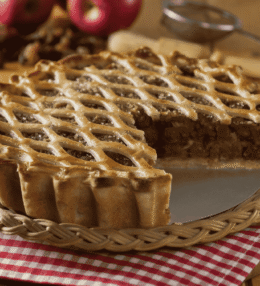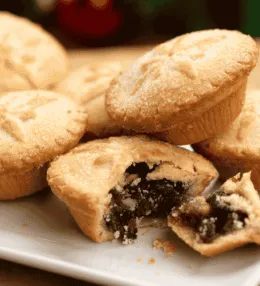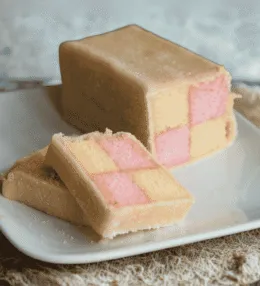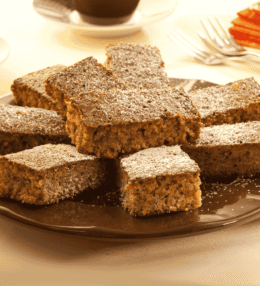
- View
Table of Contents
ToggleRožata is a celebrated dessert from Croatia’s Dalmatian coast, cherished for its smooth texture and delicate flavour. It is a custard pudding, baked with caramel and scented with a hint of rose liqueur, which gives the dish its distinctive name.
This pudding is simple at first glance yet offers a complexity that reveals itself with each spoonful. The top layer of caramel provides sweetness and depth, while the custard underneath feels light, creamy, and gently perfumed.
It is served chilled, often following a meal of grilled fish or roasted meats. The balance between rich caramel and subtle floral notes makes it a refreshing way to end a meal without overwhelming the palate.
Want to dive deeper into Croatian Cuisine? Don’t miss our post on Traditional Croatian Foods to Try
What Is Rožata?
Rožata is Croatia’s answer to the caramel custard family of desserts. Similar to crème caramel in technique, it uses eggs, milk, and sugar as its base. What sets it apart is the inclusion of a local rose flavoured liqueur called rozalin.
The custard is baked slowly in a water bath, ensuring a silky consistency. Once cooled and inverted, the pudding reveals a golden layer of caramel that glazes the surface and flows gently over its sides when cut.
Served in slices or scoops, Rožata offers a dessert that is elegant but unpretentious. It is a dish rooted in home kitchens as much as restaurant menus, valued for its tradition and for its unique Dalmatian character.
Ingredients and Taste
The core ingredients are fresh eggs, whole milk, sugar, and caramel. Eggs provide structure, milk adds richness, and sugar delivers sweetness. The caramel, made by melting sugar to a deep amber, brings depth and slight bitterness.
Rozalin, or sometimes another flavoured liqueur, lends a floral touch that distinguishes Rožata from other custards. Vanilla and lemon zest are often added, giving brightness and balance to the creaminess of the pudding.
The flavour is smooth and layered. The first taste is sweet, followed by the roasted edge of caramel, then a gentle floral note that lingers. The texture is delicate and silky, holding shape while melting easily on the tongue.
A Taste of History
Rožata has strong roots in Dubrovnik and the wider Dalmatian region. Its name derives from rozalin, the rose liqueur that gives the dessert its fragrance. The use of this ingredient reflects the area’s history of Mediterranean trade.
It is believed that Rožata became popular during the Renaissance, when Dubrovnik thrived as a centre of culture and commerce. The dessert was served at banquets and family gatherings, symbolising refinement and hospitality.
Over time, Rožata spread beyond the coast, but it remains most closely linked with Dalmatian identity. Families often pass recipes from one generation to the next, preserving both the flavour and the story behind it.
Today, Rožata holds a firm place in Croatian cuisine. It is offered in traditional restaurants, often as the final course after a hearty coastal meal. For visitors, tasting Rožata is not only about dessert but also about experiencing a piece of living heritage.
The pudding continues to adapt, with some chefs experimenting by adding different liqueurs or flavourings, yet the classic version remains widely preferred. It reflects a culinary tradition that values balance, restraint, and a respect for local ingredients.
How to Make Rožata (Caramel Custard Pudding)
Rožata is a classic dessert from Dubrovnik, admired for its silky custard, delicate citrus notes, and glossy caramel topping. The process requires patience with caramelising sugar and gentle baking in a water bath to achieve the smoothest texture. See the recipe card at the bottom for printable directions
Ingredients
For the caramel
- 150g granulated sugar
- 2 tbsp water
For the custard
- 500ml whole milk
- 5 large eggs
- 120g granulated sugar
- 1 tsp vanilla sugar or ½ vanilla pod
- 1 tsp grated lemon zest
- 1 tsp grated orange zest
- 1 tbsp rose liqueur (Rozalin, traditional) or rose water
Cooking Instructions
Step 1: Preheat the oven
To begin, preheat your oven to 160°C. Prepare a deep baking tray large enough to hold your pudding mould or ramekins for the water bath. Move on to caramel preparation.
Step 2: Make the caramel
In a small saucepan, heat 150g sugar with 2 tbsp water over medium heat until it melts and turns a rich amber colour. Do not stir; swirl the pan gently to prevent crystallisation. Transition to coating the mould.
Step 3: Coat the mould
Quickly pour the caramel into the base of your pudding mould or four individual ramekins. Tilt to coat the bottom evenly before the caramel sets. Allow to cool and harden while preparing the custard.
Step 4: Infuse the milk
Warm the milk in a saucepan with vanilla sugar (or split vanilla pod) until just steaming, not boiling. Remove from heat and let it infuse for 10 minutes. Move to egg preparation.
Step 5: Beat the eggs and sugar
In a large bowl, whisk the eggs with 120g sugar until pale and combined. Do not over whisk, as too much air creates bubbles in the custard. Proceed to combining with milk.
Step 6: Combine milk and eggs
Slowly pour the warm infused milk into the egg mixture while whisking gently. Add lemon zest, orange zest, and rose liqueur. Strain the mixture through a sieve for a smooth texture. Transition to filling the moulds.
Step 7: Fill the moulds
Pour the custard into the caramel coated mould or ramekins. Place them in the deep baking tray. Transition to setting up the water bath.
Step 8: Prepare the water bath
Fill the tray with hot water to reach halfway up the sides of the moulds. This ensures gentle, even cooking. Move to baking.
Step 9: Bake the custard
Place in the oven and bake for 45–55 minutes, until the custard is set but still has a slight wobble in the centre. Remove from the oven and cool completely at room temperature. Then refrigerate for at least 4 hours, preferably overnight.
Final Step: Unmould and serve
Run a thin knife around the edges of the pudding. Invert onto a plate so the caramel flows over the custard. Serve chilled, with no garnish required beyond its glossy caramel crown, though candied citrus peel makes a beautiful addition.
Variations and Substitutions
- If rose liqueur is unavailable, use rose water for a fragrant substitute.
- Replace vanilla sugar with vanilla extract if necessary.
- Individual ramekins make for easier serving, though a large mould is traditional.
- For a lighter version, use half milk and half cream, though full milk gives the authentic balance.
Cooking Tips for Perfect Rožata
- Caramel hardens quickly, so work fast when coating the mould.
- Avoid over whisking eggs to keep the custard silky and free from bubbles.
- Always strain the custard mixture before baking for an ultra-smooth finish.
- A slow bake in a water bath prevents curdling and keeps the custard delicate.
- Chill thoroughly before unmoulding for clean slices and stable texture.

Rožata (Caramel Custard Pudding)
Ingredients
For the caramel
- 150 g granulated sugar
- 2 tbsp water
For the custard
- 500 ml whole milk
- 5 large eggs
- 120 g granulated sugar
- 1 tsp vanilla sugar or ½ vanilla pod
- 1 tsp grated lemon zest
- 1 tsp grated orange zest
- 1 tbsp rose liqueur Rozalin, traditional or rose water
Instructions
- To begin, preheat your oven to 160°C. Prepare a deep baking tray large enough to hold your pudding mould or ramekins for the water bath. Move on to caramel preparation.
- In a small saucepan, heat 150g sugar with 2 tbsp water over medium heat until it melts and turns a rich amber colour. Do not stir; swirl the pan gently to prevent crystallisation. Transition to coating the mould.
- Quickly pour the caramel into the base of your pudding mould or four individual ramekins. Tilt to coat the bottom evenly before the caramel sets. Allow to cool and harden while preparing the custard.
- Warm the milk in a saucepan with vanilla sugar (or split vanilla pod) until just steaming, not boiling. Remove from heat and let it infuse for 10 minutes. Move to egg preparation.
- In a large bowl, whisk the eggs with 120g sugar until pale and combined. Do not over whisk, as too much air creates bubbles in the custard. Proceed to combining with milk.
- Slowly pour the warm infused milk into the egg mixture while whisking gently. Add lemon zest, orange zest, and rose liqueur. Strain the mixture through a sieve for a smooth texture. Transition to filling the moulds.
- Pour the custard into the caramel coated mould or ramekins. Place them in the deep baking tray. Transition to setting up the water bath.
- Fill the tray with hot water to reach halfway up the sides of the moulds. This ensures gentle, even cooking. Move to baking.
- Place in the oven and bake for 45–55 minutes, until the custard is set but still has a slight wobble in the centre. Remove from the oven and cool completely at room temperature. Then refrigerate for at least 4 hours, preferably overnight.
- Run a thin knife around the edges of the pudding. Invert onto a plate so the caramel flows over the custard. Serve chilled, with no garnish required beyond its glossy caramel crown, though candied citrus peel makes a beautiful addition.







Leave a Review